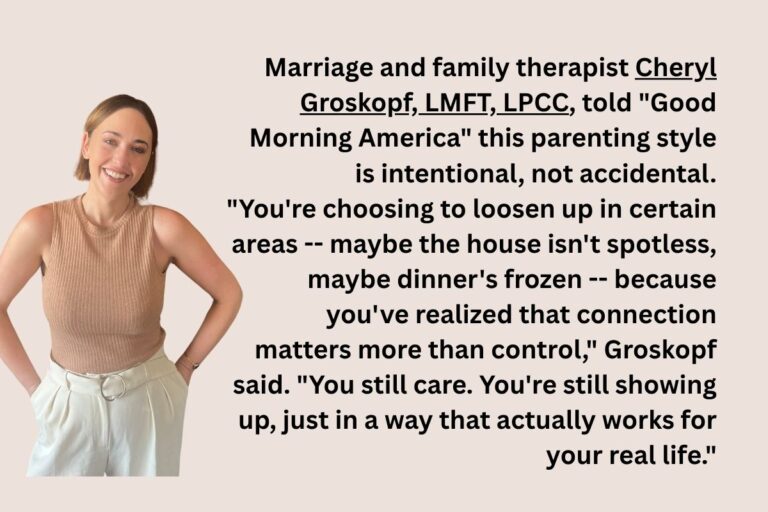TikTok trauma trends in Los Angeles are everywhere — but not everything that goes viral actually supports healing. As a trauma therapist, I see the gap between what people learn online and what their nervous system still holds onto in real life. This blog breaks down what those trends get right, what they miss, and how real therapy helps you heal at the level where it actually matters — in your body.

Cheryl Groskopf, LMFT, LPCC is a somatic trauma therapist based in Los Angeles. She helps high-functioning adults who’ve done the talk therapy and self-help thing but still feel stuck in survival mode. Cheryl’s been featured in Verywell Mind, MindBodyGreen, and ABC News, and specializes in nervous system healing through IFS, somatic therapy, and attachment-focused work.
I see it in sessions all the time: a client will say, “I saw this TikTok about fawning and finally felt like someone was describing me.”
That kind of moment — where your lived experience suddenly has a name — can be incredibly validating. For so many people, social media has been their first real introduction to concepts like dissociation, shutdown, or nervous system overwhelm.
That visibility matters. It helps people feel less alone, and it’s often the first step toward realizing their symptoms aren’t random or personal failures. They’re patterns. And those patterns formed for a reason.
But here’s the catch: when content goes viral, it often skips the nuance. Nervous system trauma responses are rooted in the body — in sensations you can’t always name. Like the part of you that gets foggy when someone raises their voice. Or the muscle tension that shows up when you try to relax. Or that low-key panic you feel when you have to say no.
And that’s not something a trending soundbite can fully explain.
In therapy, we go deeper. Not just naming the pattern, but gently teaching your body that it doesn’t have to stay in defense mode forever. And that’s a process — not a performance.
If this sounds familiar, you might benefit from somatic therapy, which works directly with how trauma lives in the body. It’s not about fixing symptoms — it’s about building a felt sense of safety where there used to be survival.

Some of the most viral TikToks about trauma aren’t about fawning or shutdown — they’re about overanalyzing.
“What if I said the wrong thing?”
“Did I just ruin everything?”
“What if I just hadn’t sent that text?”
This isn’t just anxiety. It’s a form of magical thinking rooted in hyper-responsibility — the belief that every small decision has the power to derail your life.
In Verywell Mind, I explained how this kind of pressure shows up in relationships. When you’ve learned to internalize every outcome, you stop seeing dynamics as co-created — and start believing that if something goes wrong, it’s all your fault. That kind of thinking doesn’t stay in your head. It shows up in your body as bracing, vigilance, and paralysis around even minor choices.
Therapy helps you unwind this. We work with the part of you that panics when things feel out of your control. The part that keeps trying to predict every possible outcome just to avoid disappointment or shame. Not by giving you more control — but by helping your system feel safe even when things are uncertain.
Because not every moment is a make-or-break moment. Some things can shift without breaking you. That’s what we work on — together.

The rise of trauma-informed content on TikTok has changed the conversation — but it’s also blurred the lines between helpful education and oversimplified advice.
You’ve probably seen it: “fawn equals being too nice,” or “softness is a trauma response.” And while these interpretations get clicks, they flatten something much more complex.
Fawning, for example, isn’t just a behavior. It’s a nervous system adaptation. Your body isn’t being sweet to impress anyone — it’s working to prevent rupture. The smile, the agreement, the quick apology… all of it can be a strategy that formed when saying no didn’t feel safe. And while social media has helped name it, it rarely shows how to unlearn it in the body.
Trends like the soft girl era might encourage emotional openness and rest, which are beautiful in theory. But when they’re used as a workaround for actual trauma recovery, or treated as a step-by-step solution, it becomes another version of self-policing. A new identity layered over an old wound.
Real trauma work doesn’t rely on curated softness. It invites honesty — even when what comes up isn’t pretty or easy.
If you recognize yourself in this, you might want to explore trauma therapy in Los Angeles, where we don’t just talk about coping strategies — we work with how they live in your nervous system.
“Type C parenting” started as a smart, compassionate way to describe a parent who’s highly attuned, emotionally responsive, and gentle. It was meant to counter older styles of parenting that were cold or dismissive. But on TikTok, it’s becoming something else: a new standard that says you’re failing if you ever lose your cool or forget a feeling check-in.
I talked about this in ABC News, The New York Post, and Parents — not because Type C parenting is bad, but because it’s being warped into a kind of gentle-parenting perfectionism that isn’t sustainable.
And for the parents I work with, especially those breaking generational cycles, this pressure is real. They’re parenting from their nervous system, too — and if your system is overwhelmed or still recovering from your own trauma, it’s almost impossible to be perfectly present 100% of the time. Not because you’re not trying. But because you’re human.
TikTok often skips that part. It turns real-world parenting into a performance — and when every moment is “content,” it’s easy to feel like you’re doing it wrong.

Some people freeze when overwhelmed. Others go into overdrive.
They meal prep, meditate, budget, walk 10,000 steps. It looks like discipline. But underneath, it’s about control.
This is the pattern I see most often in high-functioning clients: burnout that doesn’t come from laziness or poor boundaries, but from a nervous system that equates rest with risk. Slowing down feels like dropping the ball. So instead, they keep moving.
I talked about this in Verywell Mind, where I explained how impulsive spending — or hyper-control around spending — can be a way to bypass emotional discomfort. Instead of feeling sadness, boredom, or tension, your brain jumps straight to action. You buy something, plan something, fix something — not because you’re “bad with money,” but because your system learned that doing feels safer than feeling.
The wellness routines, the productivity hacks, even the “no-spend” rules — they’re not bad. But when they become automatic, when they override emotional awareness, they stop being tools for regulation and start becoming survival strategies.
Real regulation isn’t about doing everything right. It’s about slowing down enough to actually hear what your body’s trying to say.
This is where holistic trauma therapy becomes essential.
It asks: What’s fueling this need to stay on top of everything? And more importantly, how can we help your body feel safe without that constant vigilance?
This work isn’t about stopping the doing. It’s about helping your nervous system trust that you don’t have to earn your safety through performance.
In sessions, we explore how shame and control show up in the body — not as abstract ideas, but as patterns in your breath, tension, posture, and pace. From there, we build a new relationship with rest that doesn’t activate guilt or panic.
If that lands, holistic therapy in Los Angeles might be a good next step. It doesn’t ask you to stop being capable — just to stop sacrificing your body’s sense of safety to keep it all together.

Teenagers today aren’t just dealing with academic pressure — they’re navigating emotional comparison at a speed and scale we’ve never seen before.
Every scroll invites them to self-monitor: Am I grounded enough? Am I healing fast enough? Do I look as emotionally evolved as she does in that 15-second clip?
This is where TikTok gets tricky. Trends around emotional intelligence, vulnerability, or self-care aren’t neutral — they’re often presented like goals to be achieved or identities to be perfected.
In Parents.com’s article on promposals, I talked about how these grand public gestures, meant to be romantic or fun, can create invisible pressure for teens to keep up. Even when they’re not directly involved, they’re comparing. And that comparison gets stored in the body — often as anxious anticipation, stomach tension, or the kind of hypervigilance that feels like buzzing under the skin.
This kind of social exposure doesn’t just create stress — it reactivates attachment dynamics. If a teen already learned to earn attention through performance or avoid conflict by staying quiet, social media gives those patterns a 24/7 stage.
In another Parents feature on skincare trends, I explained how these routines aren’t always about health — they can be a way for teens to feel in control when emotions feel unmanageable. And when self-worth gets tied to routines or appearances, any deviation can register as failure.
These aren’t just habits. They’re adaptations.
That’s why in attachment-focused therapy, I don’t just talk to teens (or adults) about behavior — we look at what their nervous system learned to expect in relationships. And how that expectation now plays out on autopilot, even through a phone screen.
By the time most people reach out for trauma therapy, they already know their patterns. They’ve read the books. Watched the TikToks. Maybe even done years of talk therapy. And they’re still wondering: Why does this keep happening?
That question isn’t a sign you missed something. It’s a sign that your body hasn’t had a different experience yet.
In the work I do with clients, we don’t just talk about emotions or analyze behavior. We track how your body has learned to anticipate threat — even when nothing bad is happening.
That might show up as:
What we’re really doing in therapy is creating the conditions for safety to be relearned — gently, in real time, with someone attuned to what’s happening in your system. Not forced. Not rushed. Just layered in, moment by moment, until your body recognizes this is different.
There’s no one-size-fits-all. But here’s what clients often notice in this process:
It’s not linear. It’s not always comfortable. But it’s real — and over time, that’s what makes it sustainable.
If you’re curious what that could look like for you, reach out here. You don’t need to have it all figured out. You just need to want something different than survival mode.

TikTok can help you name things like fawning, hyper-independence, or inner conflict. But it can’t always explain why they keep showing up — or how to shift them.
If you’ve already done talk therapy, read the books, and still feel torn between different parts of yourself… that’s not resistance. It’s survival.
In therapy, I use IFS (Internal Family Systems) to help clients understand why one part of them wants connection, but another goes numb. Or why one part wants to speak up — and another immediately floods with shame.
This kind of internal push-pull is especially common for people with complex PTSD, whose nervous systems were shaped by emotional chaos, parentification, or conditional safety — long before they had language for any of it.
Social media might help you name your parts. IFS therapy helps those parts start to trust each other — and you.
If you’ve watched a hundred TikToks and still don’t know whether you’re “trauma-informed” or just anxious… welcome to the club. This is one of the biggest things I help clients untangle.
Anxiety and trauma can look different, but they often overlap — especially in high-functioning people who feel stuck in overdrive but can’t explain why.
The issue? TikTok rarely shows you what anxiety looks like in the body. It talks about symptoms — not what your nervous system is doing underneath them.
If you’re exhausted, irritable, hyper-aware of how others perceive you, or can’t fully exhale even on your best days, it might be time for anxiety therapy that actually works with your body — not against it.
Because you don’t need more hacks. You need a system that feels safe enough to stop scanning for threat all the time.
I’m Cheryl Groskopf — a somatic trauma therapist based in Los Angeles. I’m dual-licensed (LMFT, LPCC), and I work with adults who are smart, self-aware, high-functioning… and totally exhausted from living in survival mode.
If you’ve already done talk therapy and still feel stuck in your body, you’re not alone. That’s the exact place most of my clients start. I use somatic therapy, IFS (parts work), and attachment-focused approaches to help people finally feel safe in ways they’ve never experienced — not just understand why they don’t.

My work’s been featured in Verywell Mind, MindBodyGreen, ABC News, Parents.com, and other media outlets where trauma and nervous system healing are becoming part of the mainstream conversation. I love that these topics are gaining visibility — but short-form content doesn’t always show people how to actually heal. That’s where therapy comes in.
Want to learn more about somatic therapy in Los Angeles or see if we’d be a good fit? Reach out here — I’d love to hear from you.
If you’ve tried to heal through self-awareness, mindset shifts, or TikTok tips—and you’re still feeling stuck—this is the next step.
I help clients in Los Angeles (and across California) who are tired of understanding their trauma but not actually feeling better. You don’t have to keep trying to fix it alone. You don’t have to feel this way forever.
Schedule a free consultation and let’s talk about what real healing could look like—for your nervous system, your relationships, and your sense of self.
It depends. For some people, being able to name their patterns for the first time is life-changing. But for others, constantly seeing trauma content can keep them stuck in awareness mode — watching instead of integrating. If you find yourself doom-scrolling trauma TikTok and feeling more anxious afterward, that’s a cue from your system. It’s not weakness. It’s overstimulation. Your body’s asking for a slower, more supportive way to process what’s coming up.
Yes — and that doesn’t mean you’re regressing. Many clients feel more emotionally raw or irritable once they begin identifying how their coping strategies have been running on autopilot.
This isn’t failure — it’s the body realizing it has other options, which can stir up grief, fear, or confusion before clarity sets in. Therapy helps you stay with that process safely so you don’t shut it down out of habit.
Awareness is totally helpful, but only if it’s connected to curiosity and compassion. If it feels like pressure to “fix yourself faster” or constantly label your responses, it might actually be keeping you in your head. In therapy, I help clients shift from mental insight to body-based integration — so healing stops being something they have to manage and starts becoming something they feel.
Because safety isn’t just about what’s happening around you — it’s about what your body has learned to expect inside relationships, emotions, and even stillness.
If you’ve had to spend years adapting to unpredictability or emotional intensity, it doesn’t just shut those alarms off because your circumstances changed. That’s where trauma therapy comes in. Working with someone trained in somatic therapy can help your body gradually unlearn the belief that calm = danger, and show it how to feel safe without needing to be constantly “on.”
Social media might spark the curiosity. But real healing? It needs more than a 30-second clip.
If this post has you wondering whether your nervous system is still stuck in a trauma response — or whether your body’s been carrying tension longer than you realized — I wrote a few deeper dives that might help:
10 Signs Your Body Is Still Holding Onto Trauma – A breakdown of what “holding trauma in the body” actually looks like day-to-day. Not just freeze mode. Not just panic. Subtle stuff, like always over-apologizing or feeling like you’re too much.
Which Type of Trauma Therapy Is Right for You? – Not all trauma therapy works the same way. This post walks through what’s available in L.A., and how to know what’ll feel safest for your system — especially if traditional talk therapy hasn’t helped.
Understanding the Fight, Flight, Freeze, and Fawn Responses – If you’re noticing patterns in your relationships or your anxiety that feel automatic or out of proportion, this post might help explain why. And what to do with that awareness once you have it.
Want to skip the scroll and go straight to support? Learn more about trauma therapy in Los Angeles and what it actually looks like to work through these patterns — gently, without retraumatizing yourself.
